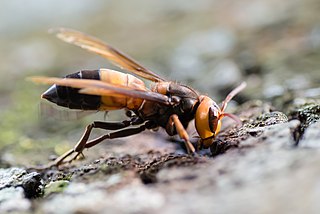Related Research Articles

The Zygaenidae moths are a family of Lepidoptera. The majority of zygaenids are tropical, but they are nevertheless quite well represented in temperate regions. Some of the 1000 or so species are commonly known as burnet or forester moths, often qualified by the number of spots, although other families also have 'foresters'. They are also sometimes called smoky moths.

The Nordic Stone Age refers to the Stone Age of Scandinavia. During the Weichselian glaciation, almost all of Scandinavia was buried beneath a thick permanent ice cover, thus, the Stone Age came rather late to this region. As the climate slowly warmed up by the end of the ice age, nomadic hunters from central Europe sporadically visited the region. However, it was not until around 12,000 BCE that permanent, but nomadic, habitation in the region took root.
A metatheory or meta-theory is a theory the subject matter of which is theory itself, for example as an analysis or description of existing theory. For mathematics and mathematical logic, a metatheory is a mathematical theory about another mathematical theory. Meta-theoretical investigations are part of the philosophy of science. The topic of metascience is an attempt to use scientific knowledge to improve the practice of science itself.

Evolution and Human Behavior is a bimonthly peer-reviewed academic journal covering research in which evolutionary perspectives are brought to bear on the study of human behavior, ranging from evolutionary psychology to evolutionary anthropology and cultural evolution. It is primarily a scientific journal, but articles from scholars in the humanities are also published. Papers reporting on theoretical and empirical work on other species may be included if their relevance to the human animal is apparent. The journal was established in 1980, and beginning with Volume 18 in 1997 has been published by Elsevier on behalf of the Human Behavior and Evolution Society. The editor-in-chief is Debra Lieberman.

Human habitation of present-day Sweden began around 12000 BC. The earliest known people belonged to the Bromme culture of the Late Palaeolithic, spreading from the south at the close of the Last Glacial Period. Neolithic farming culture became established in the southern regions around 4000 BC, but much later further north. About 1700 BC the Nordic Bronze Age began in the southern regions, based on imported metals; this was succeeded about 500 BC by the Iron Age, for which local ore deposits were exploited. Cemeteries are known mainly from 200 BC onward.

Kenneth B. Storey is a Canadian scientist whose work draws from a variety of fields including biochemistry and molecular biology. He is a Professor of Biology, Biochemistry and Chemistry at Carleton University in Ottawa, Canada. Storey has a world-wide reputation for his research on biochemical adaptation - the molecular mechanisms that allow animals to adapt to and endure severe environmental stresses such as deep cold, oxygen deprivation, and desiccation.
Abdullah Al Mamun is a Bangladeshi physicist who is a professor of physics at Jahangirnagar University, Dhaka, Bangladesh.

Daniel Simon Mills, FRCVS is an English veterinarian and biologist and the UK's first Professor of Veterinary Behavioural Medicine based at the University of Lincoln, United Kingdom. He attended St Edmund's College, Ware before studying at the University of Bristol where he received his BVSc degree and completed his Ph.D. degree in animal behaviour from De Montfort University.

The Three Rs (3Rs) are guiding principles for more ethical use of animals in product testing and scientific research. They were first described by W. M. S. Russell and R. L. Burch in 1959. The 3Rs are:
- Replacement:methods which avoid or replace the use of animals in research
- Reduction: use of methods that enable researchers to obtain comparable levels of information from fewer animals, or to obtain more information from the same number of animals.
- Refinement: use of methods that alleviate or minimize potential pain, suffering or distress, and enhance animal welfare for the animals used.
Comparative medicine is a distinct discipline of experimental medicine that uses animal models of human and animal disease in translational and biomedical research. In other words, it relates and leverages biological similarities and differences among species to better understand the mechanism of human and animal disease. It has also been defined as a study of similarities and differences between human and veterinary medicine including the critical role veterinarians, animal resource centers, and Institutional Animal Care and Use Committees play in facilitating and ensuring humane and reproducible lab animal care and use. The discipline has been instrumental in many of humanity's most important medical advances.

Justine Shaw is an Australian Antarctic researcher, best known for her conservation work on subantarctic islands, currently working at the Queensland University of Technology. She has a wide global research network, having worked in Australia, South Africa, sub-Antarctic/Antarctic and the Arctic.
Innes C. Cuthill is a professor of behavioural ecology at the University of Bristol. His main research interest is in camouflage, in particular how it evolves in response to the colour vision of other animals such as predators.
Network-based diffusion analysis (NBDA) is a statistical tool to detect and quantify social transmission of information or a behaviour in social networks. NBDA assumes that social transmission of a behavior follows the social network of associations or interactions among individuals, since individuals who spend a lot of time together, or who interact more have more opportunity to learn from each other. Therefore, NBDA infers social transmission if the spread of a novel behavior follows the social network of a population. NBDA thus allows the study of social learning to be linked to animal behavior research that uses social network analysis. NBDA was introduced by Franz & Nunn and further developed by Hoppitt, Boogert, & Laland.
Liz Neeley is a science communicator, researcher, and founder of Liminal Creations. She was formerly the Executive Director of The Story Collider, a nonprofit organization that focuses on true, personal stories inspired by science. She began her career in marine biology and conservation and has since become an expert in the use of narrative storytelling for effective science communication.

Vespa soror, also known as the southern giant hornet, is a species of hornet present in India, Northern Thailand, Laos, Northern Vietnam, and parts of South China, including Hong Kong, Guangdong, Fujian, and Hainan Island.
Animal Study Registry is an online registry for the preregistration of research studies involving animals. Animal Study Registry was launched in January 2019 and can be used by scientists worldwide.

Anne Elisabeth Osbourn is a professor of biology and group leader at the John Innes Centre, where she investigates plant natural product biosynthesis. She discovered that in the plant genome, the genes involved with biosynthesis organise in clusters. She is also a popular science communicator, poet and is the founder of the Science, Art and Writing (SAW) Initiative. She was elected a member of the National Academy of Sciences in 2022.
Joy M. Bergelson is an American evolutionary biologist. She is currently the Dorothy Schiff Professor of Genomics at New York University. Bergelson was previously and James D. Watson Distinguished Service Professor of Ecology and Evolution at the University of Chicago, where she chaired the department for ecology and evolution. Her research focuses on the evolution and ecology of plants.
Sex as a biological variable (SABV) is a research policy recognizing sex as an important variable to consider when designing studies and assessing results. Research including SABV has strengthened the rigor and reproducibility of findings. Public research institutions including the European Commission, Canadian Institutes of Health Research, and the U.S. National Institutes of Health have instituted SABV policies. Editorial policies were established by various scientific journals recognizing the importance and requiring research to consider SABV.
Robert Insall is a Professor of Mathematical and Computational Cell Biology at the University of Glasgow and a Senior Group Leader at the Beatson Institute for Cancer Research. His work focuses on how eukaryotic cells move, and how they choose the direction in which they move. He is known for demonstrating that cells can spread in the body and find their way through mazes by creating gradients of chemoattractants.
References
- ↑ Sert, Nathalie Percie du; Hurst, Viki; Ahluwalia, Amrita; Alam, Sabina; Avey, Marc T.; Baker, Monya; Browne, William J.; Clark, Alejandra; Cuthill, Innes C.; Dirnagl, Ulrich; Emerson, Michael (2020-07-14). "The ARRIVE guidelines 2.0: Updated guidelines for reporting animal research". PLOS Biology. 18 (7): e3000410. doi:10.1371/journal.pbio.3000410. ISSN 1545-7885. PMC 7360023 . PMID 32663219.
- ↑ Sert, Nathalie Percie du; Ahluwalia, Amrita; Alam, Sabina; Avey, Marc T.; Baker, Monya; Browne, William J.; Clark, Alejandra; Cuthill, Innes C.; Dirnagl, Ulrich; Emerson, Michael; Garner, Paul (2020-07-14). "Reporting animal research: Explanation and elaboration for the ARRIVE guidelines 2.0". PLOS Biology. 18 (7): e3000411. doi:10.1371/journal.pbio.3000411. ISSN 1545-7885. PMC 7360025 . PMID 32663221.